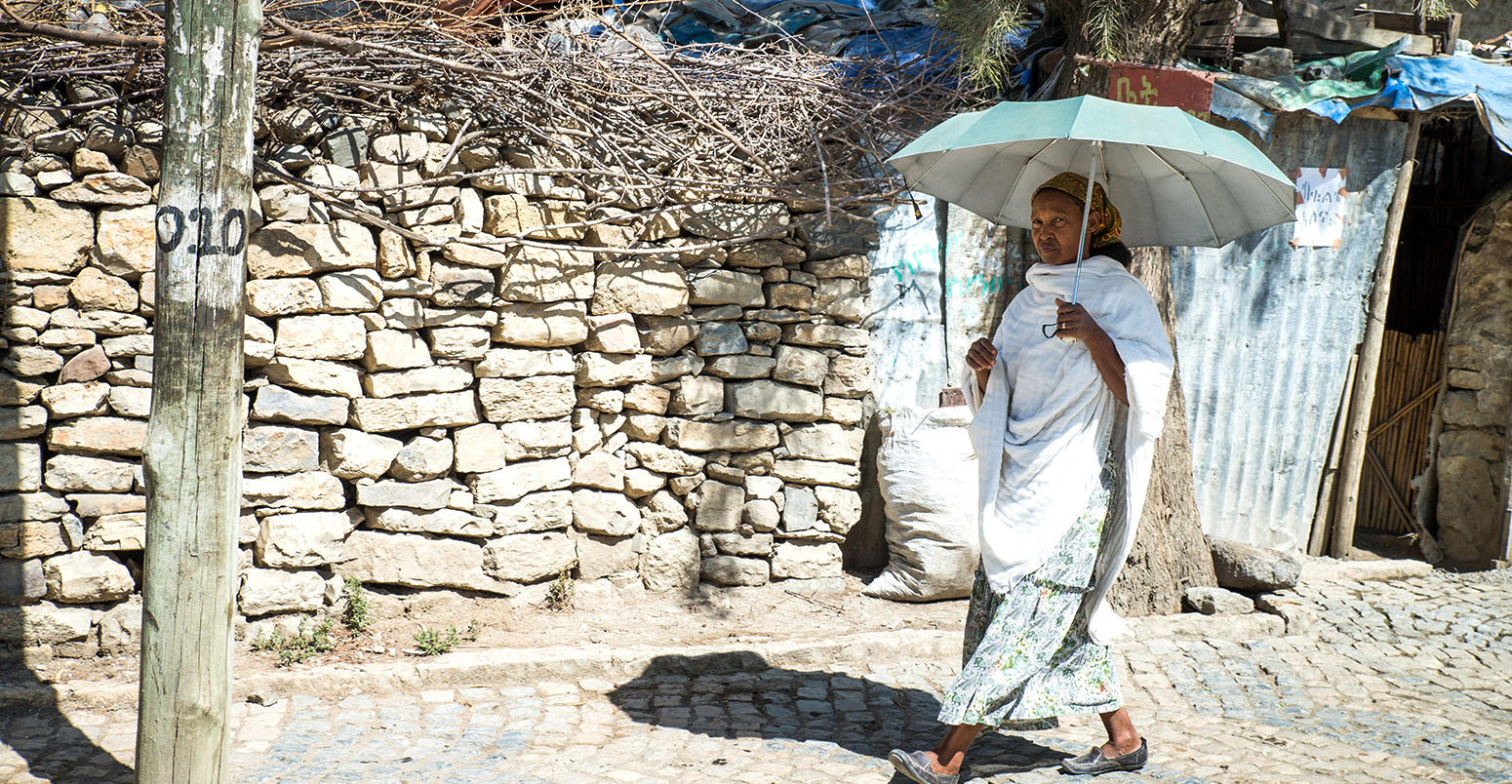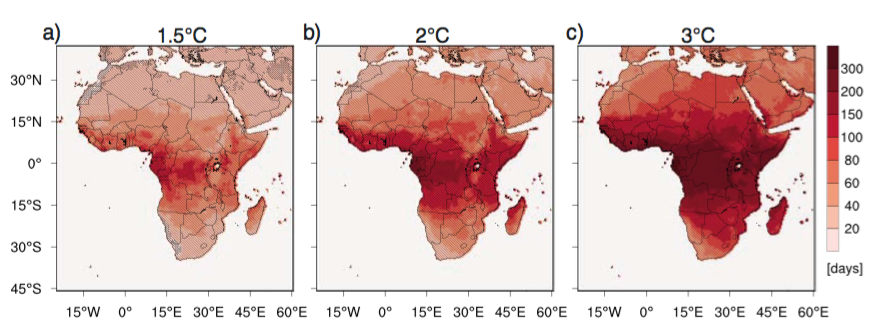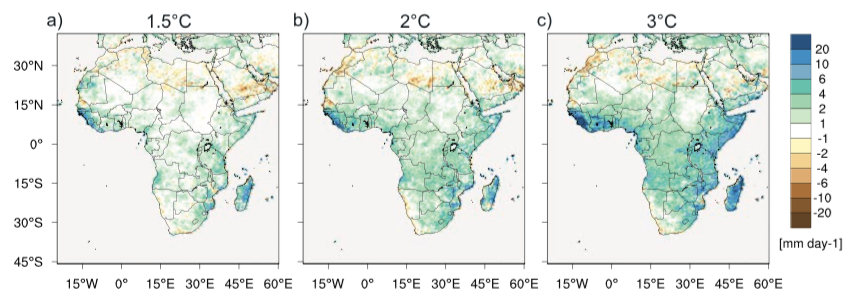
Mapped: African heatwaves could increase ‘five-fold’ with 3C of global warming
Daisy Dunne
04.27.18Daisy Dunne
27.04.2018 | 11:22amThe number of heatwaves affecting the African continent every year could be five times higher by 2050 as a result of climate change, a new study finds.
Global warming of 3C above pre-industrial levels could also alter rainfall patterns across the continent, the research says, which could bring droughts to some countries and an increase in flood risk to others.
However, limiting warming to 1.5C – the aspirational goal of the Paris Agreement – could greatly reduce the risk of heatwaves and other climate extremes in Africa, the lead author tells Carbon Brief.
Continental countdown
The new study, published in Earth’s Future, focuses on how global warming could impact a range of climate variables that tend to have a large effect on human life, including heatwaves, “hot nights” and rainfall intensity.
The research finds that any degree of global warming is likely to drive an increase in the number of heatwaves and hot nights across much of Africa by 2050.
However, the impact of climate change on rainfall patterns across Africa is less clear, says lead author Dr Torsten Weber, a scientist at the Climate Service Center Germany. He presented his research results at this year’s European Geosciences Union (EGU) General Assembly earlier this month. In an interview with Carbon Brief at the conference, he describes the main findings of the new study:
For the study, the researchers used a group of regional climate models developed by the CORDEX Africa initiative. The models were developed to help scientists address how climate change could impact the diverse climates found across Africa.
The research uses three scenarios of global warming out to the end of the century: the two long-term goals of the Paris Agreement – 1.5C and 2C – and a third scenario of 3C. This last scenario assumes that the Paris targets are missed, but that current national pledges to cut emissions are achieved.
Heating up
Heatwaves can cause severe heat stroke, which can lead to immediate deaths and exacerbate long-term health problems. Heatwaves can also have a negative impact on work productivity, especially for labourers and farmers, and cause crop failures.
The research finds that, in today’s climate, the average African region experiences one to three “heatwaves” per year. A heatwave is here defined as a period of three or more days where daily temperatures are in the top 5% of the 1971-2000 average for the region.
The number of heatwaves per year is expected to more than double by 2050 under the 1.5C warming scenario, the research finds. However, under the 3C scenario, heatwaves could increase five-fold by the middle of the century.
The maps below show projected changes to the average number of heatwave days per year across the continent under warming of 1.5C (left), 2C (middle) and 3C (right). On the charts, pink shows a small increase in the number of days while dark red shows a large increase in the number of days.

Projected changes in the number of heatwave days per year across the African continent in 2050 under warming scenarios of 1.5C (left), 2C (middle) and 3C (right). Pink shows a small increase in the number of days while dark red shows a large increase in the number of days. The dotted areas show where the results exceed a single standard deviation, while the hatched lines show where the results exceed a double standard deviation. Source: Weber et al. (2018)
The charts show that the greatest increase in heatwaves days could occur in countries in the Horn of Africa, including Somalia and Ethiopia, as well as along countries along the Atlantic coast of Central Africa, such as Gabon and Cameroon.
However, the results also show that the risk of heatwave increase could be minimised in many countries, such as the Democratic Republic of Congo and South Africa, if global warming is limited to 1.5C, says Weber:
“Although we can expect an increase in heatwaves under any degree of global warming, the pattern becomes more prominent towards higher global warming scenarios.”
Hot nights
The research also looked at how warming could influence the frequency of “hot nights” across the continent. “Hot nights” were defined as nights where temperatures are in the top 10% of the 1971-2000 average for the region.
Long, hot nights are known to exacerbate respiratory and other existing health problems, and have previously been linked to increased death rates.
The study finds that under 1.5C of warming, the African continent could experience an additional 20 to 150 hot nights each year. However, under 3C of warming, many parts of Africa could face an additional 300 nights where temperatures are in the top 10% of the historical average.
The maps below show the projected change in the number of hot nights per year under warming of 1.5C (left), 2C (middle) and 3C (right). On the charts, pink shows a small increase in the number of days while dark red shows a large increase in the number of days.

Projected increase in hot nights per year across Africa in 2050 under 1.5C (left), 2C (middle) and 3C (right) of warming. Pink shows a small increase in hot nights while dark red shows a large increase. Source: Weber et al. (2018)
The maps indicate that countries closest to the equator could experience the largest increase in the number of hot nights per year by the middle of the century. However, under 3C, large increases in hot nights are expected across much of the continent, Weber says:
“Concerning the temperature-related indices like hot nights, the region close to the equator will be especially affected. However, in the 3C scenario, many other countries, including South Africa, could be affected.”
Rainfall risks
The researchers also explored how climate change could impact rainfall intensity across the continent. In the study, an “extreme rainfall intensity” event was defined as a day where total rainfall is in the top 1% of the 1971-2000 average for the region.
Previous research shows large increases in rainfall intensity can increase flood risk, whereas large decreases can cause droughts, which can affect water availability and crop yields.
The maps below show the expected changes in the number of days with extreme rainfall intensity across Africa in 2050 under warming of 1.5C (left), 2C (middle) and 3C (right). On the charts, orange is used to show decreases in days with extreme rainfall intensity while blue is used to show increases.

Projected changes to the number of days with intense rainfall per year across Africa in 2050 under 1.5C (left), 2C (middle) and 3C (right) of warming. Orange shading shows decreases in days with extreme rainfall intensity while blue shows increases. Source: Weber et al. (2018)
The results suggest that increases in rainfall intensity are most likely to affect coastal countries, such as Madagascar, the Ivory Coast and Ghana.
Yet under the 3C scenario, a number of landlocked countries, such as the Central African Republic and Zambia, could see a moderate increase in days with intense rainfall.
Some regions could experience an overall decrease in days with intense rainfall, including parts of Morocco and South Africa.
However, the model projections for rainfall are less certain than those for temperature, notes Weber. This means the researchers cannot be certain whether the changes are driven by climate change or are just a consequence of natural climate variability. Weber explains:
“Concerning the precipitation-based indices, we have to say that the changes are not robust and within the natural variability, but I think it’s worth discussing potential tendencies which are becoming recognisable.”
Although the effect of climate change on rainfall in Africa may be still unconfirmed, the study does highlight that limiting global warming to 1.5C would “make sense” for African nations, he adds:
“There is a large difference between the scale of impacts expected at 1.5 and 2C, especially for temperature. Therefore it makes sense to strengthen the efforts to limit global temperature increase as much as possible.”
Weber, T. et al. (2018) Analyzing Regional Climate Change in Africa in a 1.5, 2, and 3C Global Warming World, Earth’s Future, doi/abs/10.1002/2017EF000714
-
Mapped: African heatwaves could increase ‘five-fold’ with 3C of global warming
-
Limiting global warming to 1.5C could cut heatwave risk across Africa, study says

